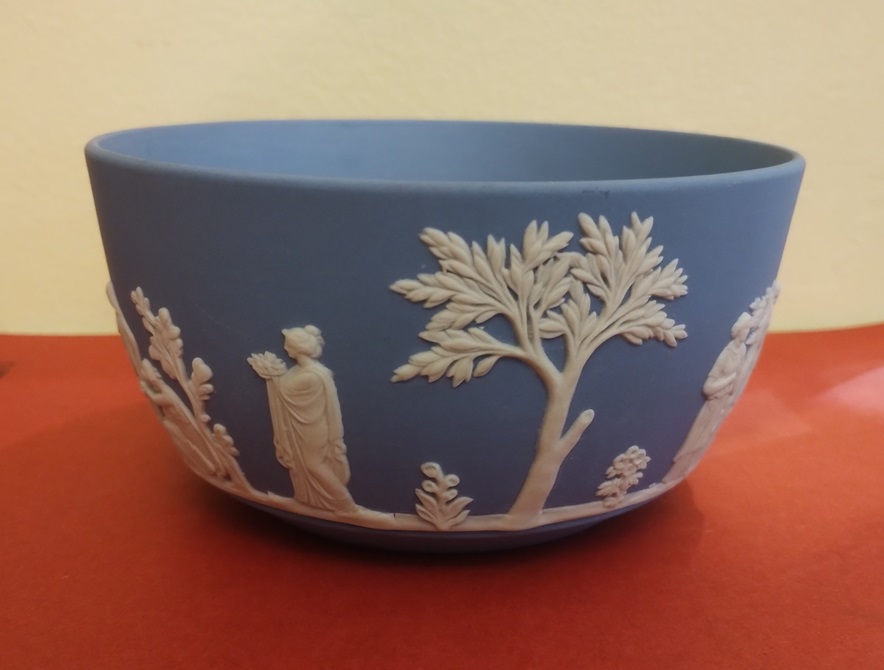
Wedgwood Jasperware is probably the most recognisable of all British pottery. A pale blue vase with white figures applied to the surface has been a mainstay British households’ selection of valuables and collectables for many decades. Today however Jasperware is largely viewed as a “Yesterday’s Antique” – something your parents or grandparents had that, frankly, you wouldn’t give houseroom to. If I’m being honest, until quite recently I’d have agreed with you all day long. If you’ll bear with me though, I’ll try to explain why I’ve come to view it very differently.
What is Wedgwood Jasperware?
Jasperware (or Jasper Ware) is a type of ceramic invented by Josiah Wedgwood, so it’s rightly synonymous with the Wedgwood company. The Jasperware name comes from the type of clay used in its production. The exact details remain, at least in theory, a company secret.
If you’re familiar with the Wedgwood name and it brings to mind a piece of pale blue pottery with white figures applied to the surface, you’ll be pleased to know you’re spot on. That’s pretty well how Jasperware started out and that blue colour is known as Wedgwood Blue. Maybe more of a surprise is that the first pieces were created in the 1770s and it remained popular until quite recently.
In the world of British ceramics, Jasperware is strange stuff. If you’ve ever had the misfortune to see a broken piece, most commonly maybe an item that has been chipped, did you notice that the colour goes all the way through pottery? We’ve all seen (or caused) broken or chipped pottery at home and usually you can see a glaze over the top of a different coloured body. The difference with Jasperware is the clay body itself is dyed during manufacturing. Jasperware is usually unglazed and is left with what’s known as a biscuit finish. It’s this that makes the surface slightly porous, slightly rough (and rather prone to surface damage and dirt).
The absence of a surface glaze means there’s no chance of the surface “crazing” you get as glaze cracks as a pot changes microscopic amounts due to temperature changes. This is very common in some types of antique pottery. With Wedgwood Jasperware is you can see a crack, put it down – it’s broken.
Not just blue (or green)
If you’ve seen a few pieces of Jasperware you will have noticed that it’s not always blue with a white design on it. A whole range of body colours are available, but it has to be said that to get examples of all of them you’ll have to look hard, and for the rarest examples have deep pockets.
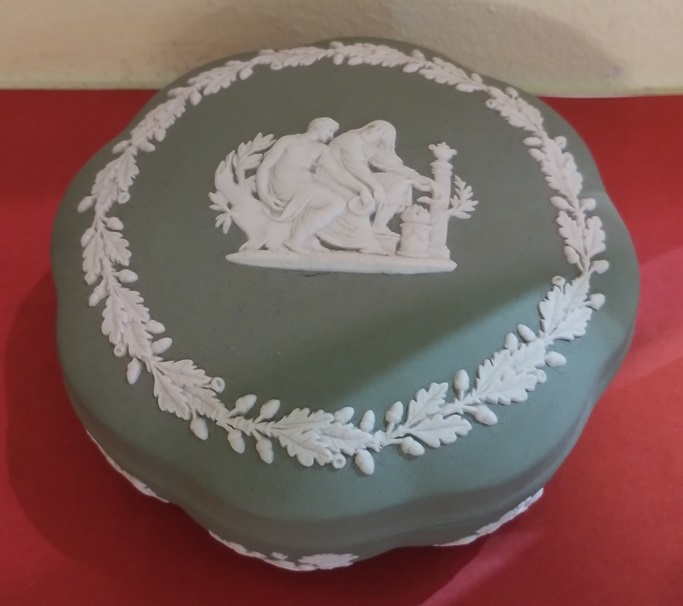
Sage green is the second most common body colour for Jasperware. This is probably followed by what is correctly called Basalt – a very dark grey/black. After that, dark blue, Royal blue, pale grey and a range pastel yellows and pinks can be found, as well as a pale, off-white colour.
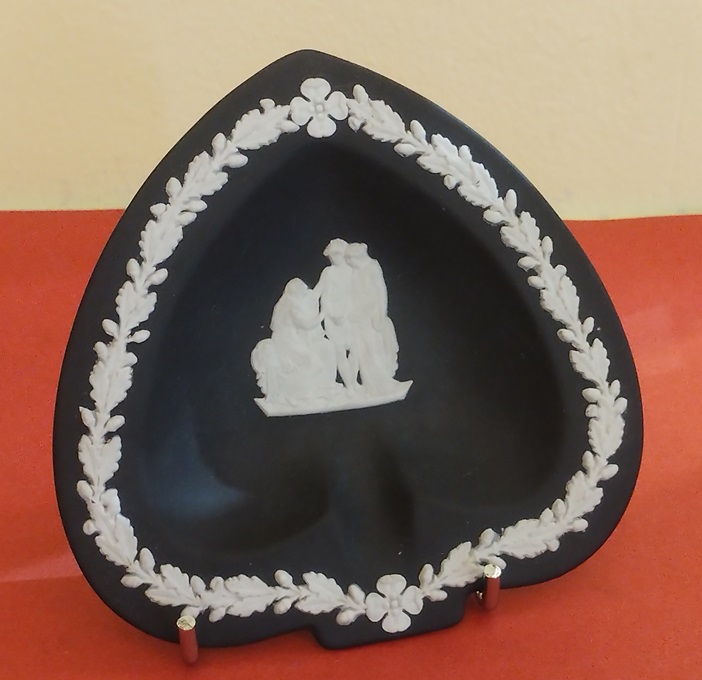
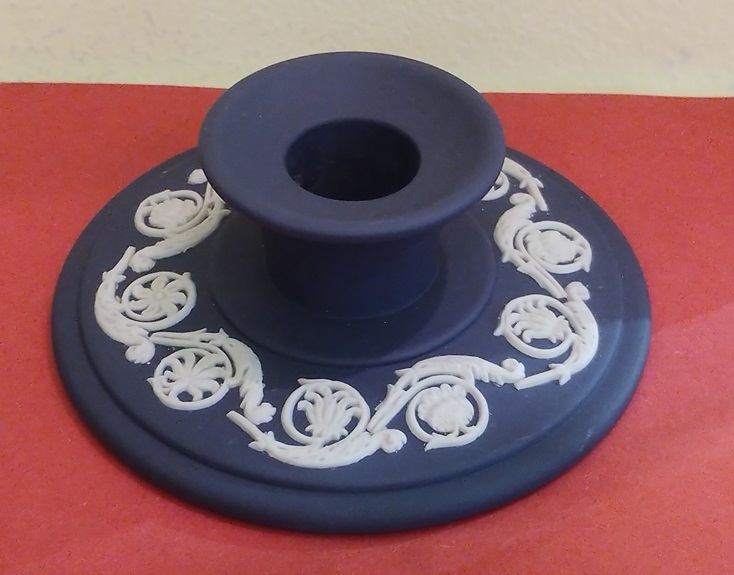
The surface designs are not always in white either. Contrasting colours are used such as sage green or blue on a pale body or basalt on a darker body.
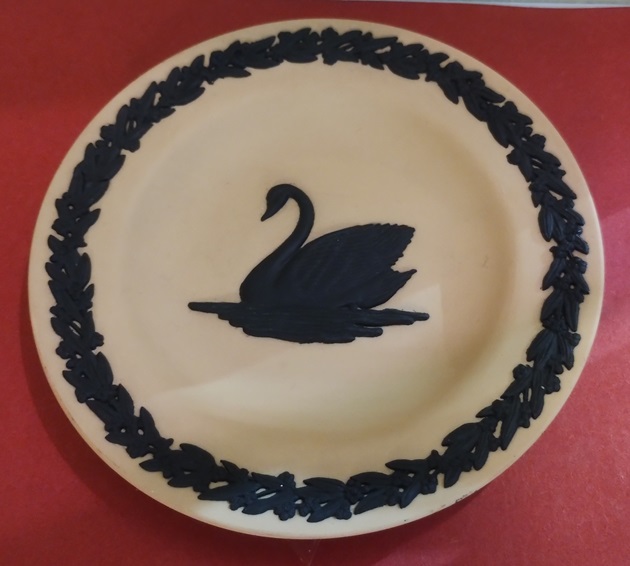
Occasionally you will find the use of two colours in the surface design but this is unusual and if you want to own an example expect to pay quite a bit more.
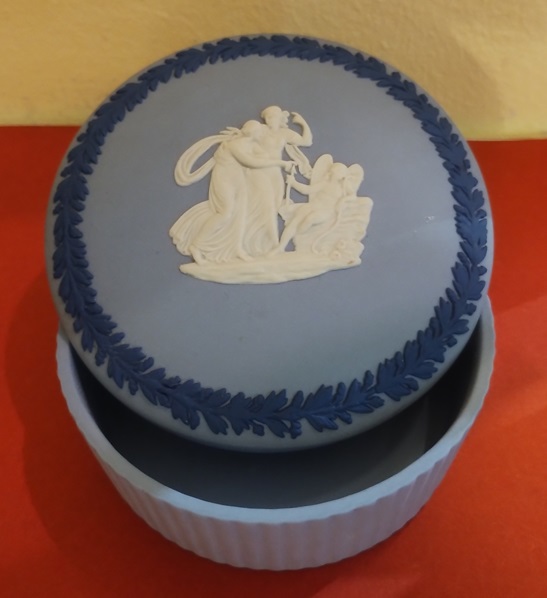
All Greek to me?
As you can see from the images above, Wedgwood Jasperware pieces are typically inspired by classical Greek or Roman designs. Most of the figures and bands of flowers and foliage that adorn the surfaces look like they began life on a vase or fresco from two thousand years ago. The leaves are often laurel. It’s a style so thoroughly ingrained in western culture that it never goes completely out of fashion, either in art or architecture.
However, to appeal to a wider audience, in recent decades Wedgwood has diversified the range of Jasperware items and the designs on them. Annual Christmas plates have been popular since the mid-1970s, as have royal commemorative plates and pin dishes. These seem to be particularly popular with overseas buyers. You can also get small candle sticks (see image above), bells and even Jasperware eggs.
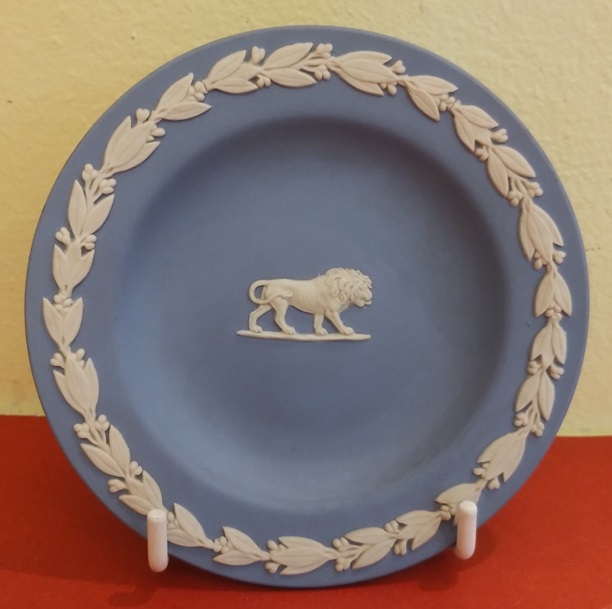
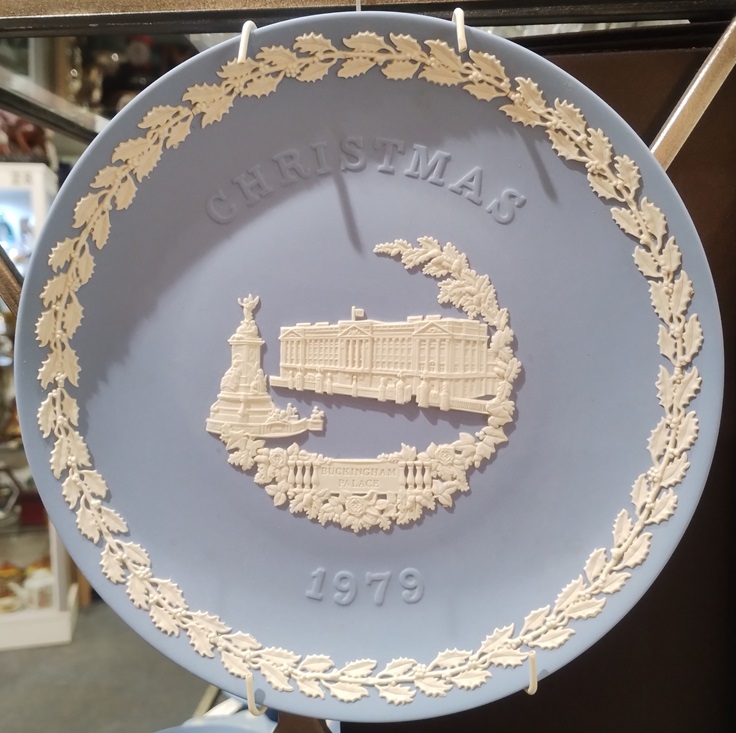
The road to my conversion
Until recently I had no interest in Jasperware. I’ve always been aware of it but dismissed it as something people used to collect but no one did any more – a classic “Yesterday’s antique”.
My change of heart started when we redecorated a room, ostensibly with grey walls but left the plaster coving white. I’d had the intention that the room would have a slightly classical look, primarily so that the walls didn’t distract from the pictures hung in there. Looking at the room when it was decorated, I thought what would look really good would be a piece of grey and white Jasperware to reflect the decoration. Ironically, I still haven’t found the piece I want, but my search made me look properly Jasperware when I came across it.
The first thing that occured to me, and one I keep coming back to, Japserware is beautifully made. The vast majority of patterned ceramics get their design from a transfer print which is then overglazed. Not so with Jasperware. It’s all hand made and hand decorated. All of it. Even the smallest pieces get their designs applied using same method as the very biggest pieces.
I would concede there’s no hand painting involved and the designs are pressed from a mould, but every piece of the design is applied by hand. Every single piece of Jasperware is a little piece of craftsmanship. In my book that beats a transfer printed design any day, no matter how pretty the design might be.
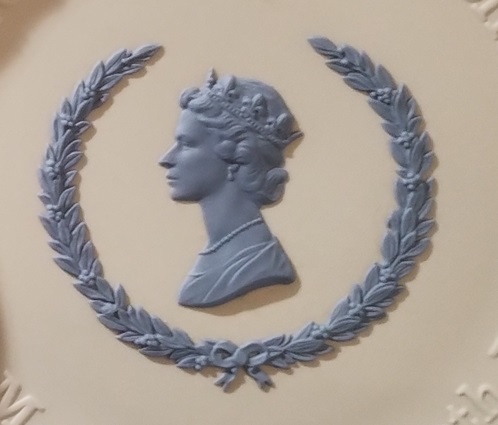
The application of the design to the surface of Jasperware also adds to the way light interacts with it. A smooth, overglazed, transfer printed design simply reflects the light evenly. Not so with Jasperware. As light moves over the surface, the textured design gains and loses shadows so you see the design for what it is – a three dimensional shape.
Almost a lone voice?
Having decided that Jasperware was worth a second look, I also realised that I was in a very small minority in Britain. Walk around any antiques fair or look at online auction listings and you can pick up small pieces of Jasperware for next to nothing. Pin trays are usually sold in groups because they have so little value on their own. Small boxes, vases and candle sticks sell for less than £10 each, often a lot less. Traders who have Jasperware usually get it as part of mixed lots from house clearance; few would ever buy it from choice. Only the larger pieces or those in unusual colour combinations attract any attention from collectors. If you get excited by Jasperware, be warned the best bits still sell of serious money!
I work a few days a month in an antiques shop where we get a lot of overseas visitors. When I started, I very quickly learned I’m not alone in liking Jasperware. It’s amazing how a stranger will give you a different view on something you take for granted. Our visitors are usually on a coach trip with only a couple of hours to spare. Many want to buy something quintessentially British and they recognise Jasperware as just that. It’s clearly something they associate with Britain and are delighted to be able to buy a piece or two for very little money.
As a holiday souvenir Jasperware is ideal, being both light, portable and fairly robust especially when it’s going to be packed into a suitcase for a long flight home. In the shop we’ll never make a fortune from selling Jasperware but there is a big consolation. Our overseas buyers are taking home a piece of well made British craftsmanship that’s a lot more durable than the tat I usually buy on holiday!
Collecting and cleaning Jasperware
If you’re inspired to start or expand a collection of Jasperware getting started couldn’t be easier. The antique shops and auctions of Britain are always have plenty on offer. If you’ve not looked before, I think you’ll be amazed at the range available.
Buying larger pieces, or pieces with the more unusual colours, will be more expensive than simple Wedgwood blue or green items but we all have to start somewhere. I’ve seen a few lovely collections of the same item reproduced in six or eight colours. When these come to auction they can be much sought after.
Damaged pieces can usually be ignored. Thankfully damage is quite rare since Jasperware is pretty robust stoneware but you should always carefully check the surface design carefully. Occasionally you’ll find pieces where the design has fragments chipped off. I’d recommend you should pass these by unless it’s a rare design or colour you really want.
The surface of Jasperware is prone to scratching as it lacks the usual hard glaze on top. Unless the scratch is deep, the mark often looks worse than it is. The damage is probably just microscopic dust that has pressed into the porous surface. A gentle washing will remove the dust and the scratch becomes invisible. Dirt can likewise be removed by washing but be patient. The porous surface can take a little while to clean.
As an experiment, we took a particularly dirty piece of Jasperware that hadn’t cost much and tried it in a dishwasher. It came out in perfect condition, completely clean. I wouldn’t suggest doing that with expensive pieces! I suspect the surface design may flake off if hot water gets behind it but if a piece is not cleanable any other way it might be worth a try – but don’t blame me if you end up with a handful of rubble.
Glazed Jasperware
You might come across some glazed ceramics that look a bit like Jasperware. If the glazing is only on the inside of a vessel, typically cups or jugs then it’s probably part of a tea set. These are intended to be used although I’d personally be very wary in case the porous areas get stained. Tea sets are quite popular with overseas buyers, so if they are being sold cheaply you might like to get in there to try selling them on.
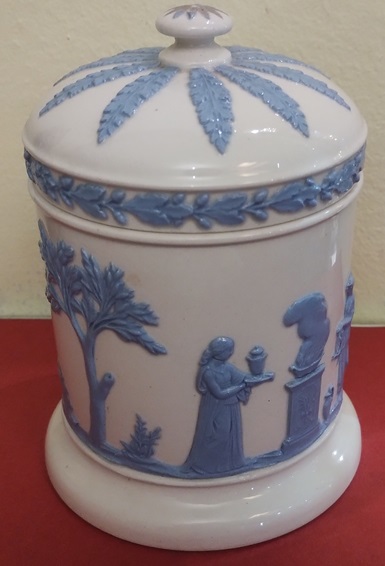
There’s another Wedgwood ceramic that sometimes looks similar to Jasperware, but is fully glazed. This is known as Queens Ware. This was designed to be used as a dinner service. Note that much Queens Ware doesn’t look like Jasperware but some of it looks like Jasperware with a rather heavy overglaze. To my eyes, this form of Queens Ware lacks the charm of Jasperware although it seems to remain quite popular with collectors.
Further Reading
The history and achievements of Josiah Wedgwood make for a fantastic read, of which Jasperware is only a part. There are lots of books and a websites. For details you’ll need a book but for a summary, a good start is the excellent Wedgwood website or the Wikipedia page on the subject.